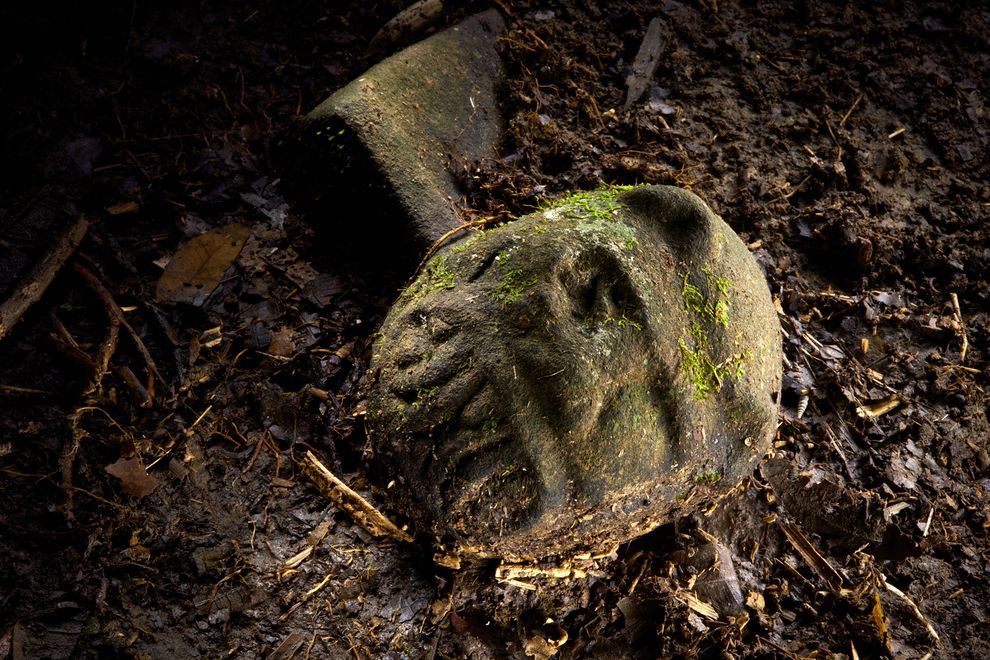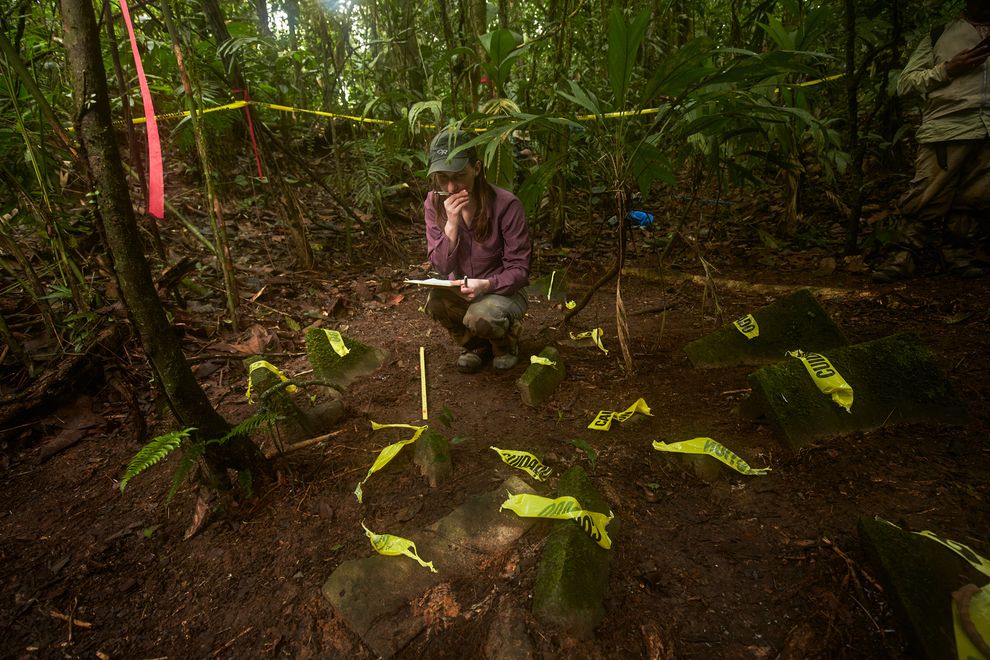It looks like you're using an Ad Blocker.
Please white-list or disable AboveTopSecret.com in your ad-blocking tool.
Thank you.
Some features of ATS will be disabled while you continue to use an ad-blocker.
share:
An ancient city of legend has been discovered after archaeologists conducted an aerial radar search after hearing persistent tales about a White City
dedicated to the monkey god. Archaeologists don't even have a name for the ancient people who once lived there, but their discovery has been an
exciting one.

goo.gl...

More information from National Geographic:
Photos by Dave Yoder, National Geographic
news.nationalgeographic.com...

The expedition has surveyed the ruins. They’ve mapped plazas, mounds and pyramids.
Most significantly, an cache of stone sculptures has found — untouched since the site was abandoned up to 1000 years ago.
Ceremonial seats. Carved vessels. Stylised creatures.
All are richly adorned with stylised snakes and vultures.
Significantly, some capture a blend of human and animal features suggesting a transformation between the two states. It’s a theme commonly attributed to Central American shamans (priest-magicians).
National Geographic reports Christopher Fisher, leader of the expedition, as saying the stash of 52 artefacts may have been an offering — but its significance is uncertain.
...
The exact location of the find is being kept secret to protect it from looters.
goo.gl...

More information from National Geographic:
An expedition to Honduras has emerged from the jungle with dramatic news of the discovery of a mysterious culture's lost city, never before explored. The team was led to the remote, uninhabited region by long-standing rumors that it was the site of a storied "White City," also referred to in legend as the "City of the Monkey God."
Archaeologists surveyed and mapped extensive plazas, earthworks, mounds, and an earthen pyramid belonging to a culture that thrived a thousand years ago, and then vanished. The team, which returned from the site last Wednesday, also discovered a remarkable cache of stone sculptures that had lain untouched since the city was abandoned.
In contrast to the nearby Maya, this vanished culture has been scarcely studied and it remains virtually unknown. Archaeologists don't even have a name for it.
Christopher Fisher, a Mesoamerican archaeologist on the team from Colorado State University, said the pristine, unlooted condition of the site was "incredibly rare." He speculated that the cache, found at the base of the pyramid, may have been an offering.
"The undisturbed context is unique," Fisher said. "This is a powerful ritual display, to take wealth objects like this out of circulation."
The tops of 52 artifacts were peeking from the earth. Many more evidently lie below ground, with possible burials. They include stone ceremonial seats (called metates) and finely carved vessels decorated with snakes, zoomorphic figures, and vultures.
The most striking object emerging from the ground is the head of what Fisher speculated might be "a were-jaguar," possibly depicting a shaman in a transformed, spirit state. Alternatively, the artifact might be related to ritualized ball games that were a feature of pre-Columbian life in Mesoamerica.
...
The ruins were first identified in May 2012, during an aerial survey of a remote valley in La Mosquitia, a vast region of swamps, rivers, and mountains containing some of the last scientifically unexplored places on earth.
Photos by Dave Yoder, National Geographic
news.nationalgeographic.com...
edit on 2-3-2015 by daaskapital
because: More information and images.
If true, what a wonderful find! Our ancient ancestors, and their; culture, knowledge, beliefs, and ways of life are SO fascinating to me.
All that amazing history still to be discovered excited me very much, and I cannot wait for further verification of this find and the sculptures and creations of those people.
Thanks for sharing this
All that amazing history still to be discovered excited me very much, and I cannot wait for further verification of this find and the sculptures and creations of those people.
Thanks for sharing this
a reply to: daaskapital
Your avatar, lol.
I've always wondered if the elite haven't already scoured the lands in search of ancient civilizations and then unfold history to us peons as they see fit to control the evolution of our species.
Your avatar, lol.
I've always wondered if the elite haven't already scoured the lands in search of ancient civilizations and then unfold history to us peons as they see fit to control the evolution of our species.
a reply to: daaskapital
I thought this sounded familiar.
I think it's even marked on my google earth.
www.livescience.com...
I thought this sounded familiar.
I think it's even marked on my google earth.
www.livescience.com...
originally posted by: WillLik
a reply to: daaskapital
I thought this sounded familiar.
I think it's even marked on my google earth.
www.livescience.com...
Thank you, I was very curious about what the digital topography looked like that clued the team into the city being there. I had begun to think it was too secret for us to know or something.
a reply to: Iamthatbish
Well, I can't find the link in my KML, But a further search brought this:
www.abovetopsecret.com...
Well, I can't find the link in my KML, But a further search brought this:
www.abovetopsecret.com...
a reply to: daaskapital
It is a real cool find in a very scary country. Searching for lost cities like that in Honduras takes some planning. You can't just go galavanting around carelessly. You need to make arrangements with locals and procure a security detachment of some sort.
I can understand why even though it was identified in 2012 it took so long to get feet on the ground there. Just getting there through rough terrain is part of it guarding against robbery or worse is the majority.
It is a real cool find in a very scary country. Searching for lost cities like that in Honduras takes some planning. You can't just go galavanting around carelessly. You need to make arrangements with locals and procure a security detachment of some sort.
I can understand why even though it was identified in 2012 it took so long to get feet on the ground there. Just getting there through rough terrain is part of it guarding against robbery or worse is the majority.
a reply to: daaskapital
Not to distract from the subject of the OP even further, but that really is a hilarious avatar.
Also, yay ancient civilizations.
Not to distract from the subject of the OP even further, but that really is a hilarious avatar.
Also, yay ancient civilizations.
Finds like this always excite me!
I think their "were-jaguar" artifact (which they haven't excavated, by the way) is probably more likely a depiction of a player in their ballgames. It looks almost exactly like the 'helmets' seen in carvings from other locations in South America.
One thing I don't understand, though....What exactly is the difference between an "earthen pyramid" and a, uh...hill?
I think their "were-jaguar" artifact (which they haven't excavated, by the way) is probably more likely a depiction of a player in their ballgames. It looks almost exactly like the 'helmets' seen in carvings from other locations in South America.
One thing I don't understand, though....What exactly is the difference between an "earthen pyramid" and a, uh...hill?
To add this cryptozoology wise there is said tales of women being kidnapped by a monkey creating half monkey/ half humans.
wiki
Morde also related a story about a monkey who had stolen three women with whom it bred, resulting in half-monkey half-human children. He claimed, “The native name for monkey is Urus, which translates literally into ‘sons of the hairy men.’ Their fathers, or fore-fathers, are the Ulaks, half-man and half-spirit, who lived on the ground, walked upright and had the appearance of great hairy ape-men.”[50] According to journalist Wendy Griffin, Nahuat speakers repeated a similar story to anthropologist James Taggart many years later.[54] In Morde's version , the hybrid children were hunted for revenge, while in the Nahuat version the child grew up to be Nahuehue, a Thunderbolt god.[50][54]
wiki
a reply to: daaskapital
So it's the City of King-Kong no less...
Daily Mail ....
So it's the City of King-Kong no less...
Theodore Morde, writing of his adventures in US magazine The American Weekly, said that local tribes people told him of the monkey worshiping civilization and went on with even more outlandish suggestions that a monkey from the city. Locals even told him that one 'monkey god' from the city kidnapped a local woman and bred half-human, half-chimp children. The children were then hunted for revenge.
It inspired the Dance Of The Dead Monkeys, during which locals roast monkeys over a fire in an apparent act of revenge for stealing their virgins.
Daily Mail ....
archaeologists are saying it seems it is an unknown civilization rather than a single city, which makes this discovery even more awesome.
this shows we have still much to learn about our History. Wonder what will come out of this. star and flag
this shows we have still much to learn about our History. Wonder what will come out of this. star and flag
I found this whole thing to be really intriguing. If it doesn't turn out to be hoax, then this is something wonderful. To think, something like this
has been under our noses this whole time! Wow!
Another South American ruins site? No doubt already looted of the gold items. If it is an entire self-sufficient civilization separate of the other
ones in the area they might find a few things that differ from the other ones but all in all I imagine it should be very much like the other ones.
a reply to: Asynchrony
No.
Honduras is part of Central America it is located above Nicaragua and below Geutamala and to the east of El Salvador.
Another South American ruins site?
No.
Honduras is part of Central America it is located above Nicaragua and below Geutamala and to the east of El Salvador.
new topics
-
Ukraine halts transit of Russian gas to Europe after a prewar deal expired
Political Conspiracies: 1 hours ago -
Welp...Happy New Year!!
General Chit Chat: 4 hours ago -
Vehicle Strikes people in New Orleans
Mainstream News: 5 hours ago -
The Hand that Rocks the Cradle - Labour Plans “diversities of our society” Curriculum Change
Regional Politics: 5 hours ago
top topics
-
Vehicle Strikes people in New Orleans
Mainstream News: 5 hours ago, 16 flags -
The Hand that Rocks the Cradle - Labour Plans “diversities of our society” Curriculum Change
Regional Politics: 5 hours ago, 5 flags -
SCOTUS Chief Justice JOHN ROBERTS Ends 2024 Describing His Fears for Safety of U.S. Judges.
Above Politics: 14 hours ago, 4 flags -
Welp...Happy New Year!!
General Chit Chat: 4 hours ago, 4 flags -
Ukraine halts transit of Russian gas to Europe after a prewar deal expired
Political Conspiracies: 1 hours ago, 4 flags
active topics
-
Ukraine halts transit of Russian gas to Europe after a prewar deal expired
Political Conspiracies • 40 • : BedevereTheWise -
Vehicle Strikes people in New Orleans
Mainstream News • 41 • : CarlLaFong -
The Hand that Rocks the Cradle - Labour Plans “diversities of our society” Curriculum Change
Regional Politics • 12 • : Flyingclaydisk -
President Carter has passed
Mainstream News • 37 • : andy06shake -
I dont understand what i just witnessed
Social Issues and Civil Unrest • 24 • : canadiandw -
New UK Petition - Close the borders! Suspend ALL immigration for 5 years!
Regional Politics • 19 • : gortex -
The C.D.C. Says There Was NO INFLUENZA Worth Reporting for the 2020-2021 Flu Season.
Diseases and Pandemics • 86 • : KrustyKrab -
Welp...Happy New Year!!
General Chit Chat • 7 • : nugget1 -
US disburses $3.4 billion in budget aid for Ukraine, Yellen says
US Political Madness • 21 • : xuenchen -
How we've changed in 100 years
Ancient & Lost Civilizations • 16 • : SprocketUK
